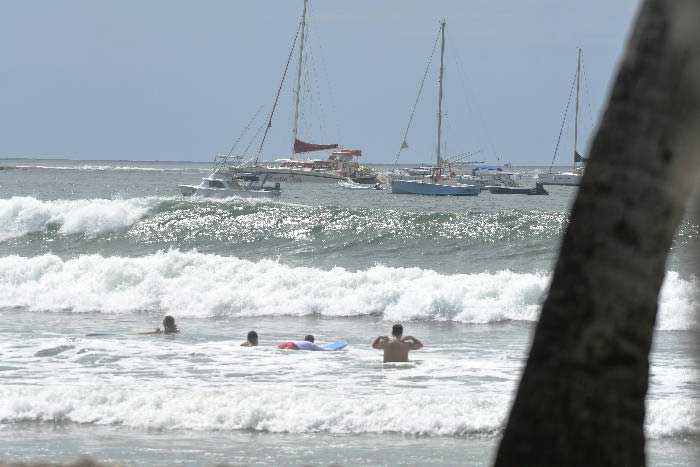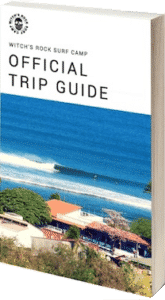
Henry's Left - Playa Tamarindo
Wave Quality: Average (6 / 10)
Ideal Swell Direction: SW (215° – 230°) NW (280° – 305°)
Ideal Wave Height: Chest – head high
Best Wind Direction: Light offshore
Best Tide: High
Required Experience: Advanced.
Best Board: Soft-top, longboard, funboard , fish, shortboard
Bottom: Lava reef
Crowd: Light
Wave Power: (5.5 / 10)
Best time of the year: July – August or December – March
Henry's Left - Playa Tamarindo
Location – Henry’s Left is located in the center of Tamarindo, approximately 200 meters south of Pico Grande and Pico Pequeño and approximately 50 meters north of Henry’s Right.
Henry’s Left breaks just past the southern edge of the Tamarindo Diria hotel.
Wave Type / Quality – Left-hand reefbreak ( 5 / 10) Average
Henry’s left sits on a lava thumb reef to the south of Pico Grande / Pequeño. The reef is triangular shaped and there is actually a right hander on the other side (see Henry’s right). The left is a quick, down-the-line wave with shallow boil sections along the way. With too much size, the wave will close out so this really limits the wave quality rating.
Ideal Swell Direction – SW (215° – 230°) NW (280° – 305°)
As we move further south along the beach, the window to the South Pacific begins to tighten and only large SW swells along with NW swells will light up Henry’s left. If the swell is too southerly (less than 210°) very little energy will be able to get past Isla Capitan directly offshore.

Ideal Wave Height – Chest – head high
Henry’s left will start working at chest high. Any smaller and the wave will be breaking right on top of the rocks. If the wave is much bigger than head high, the swell will close out and not peel along the reef.
Best Wind Direction – Light offshore
Best wind is light – moderate offshore which can range from NNE to NE to ENE. Best wind is light – moderate offshore which can range from NNE to NE to ENE. Tamarindo actually has a huge advantage over many other spots to the south because the wind will stay offshore longer. Since Tamarindo is located closer to Lake Nicaragua, the wind will stay offshore here all day while many spots to the south turn onshore around 10am. During the dry season (Dec – April) the offshore winds can be quite strong but the waves generally remain groomed.
Rubber? – Yes (December – April)
Bring some rubber especially if the winds have been blowing offshore for several days. Although rare, water temps can drop down to about 63°F. This is a phenomenon called upwelling. Normally, water temps hover in the 75° – 80°F range. Upwelling really only happens a few times during the dry season. A wetsuit top generally comes in handy for dawn patrol sessions year round.
Best time to score? – July – August and December – March
July and August are known as Costa Rica’s “Mini-Summer” months where we receive consistent SW swells and offshore winds. This is your best chance of scoring a big SW swell with clean conditions. December – March is when we receive NW swells and this unique angle (280° – 300°) is what will light up Henry’s left more commonly.

Best Tide – High
High tide is ideal at Henry’s Left. The rocks need to be mostly covered so you don’t drag your fins on the boiling dry reef sections. Also, with the higher tide, SW swells have a better chance of bypassing the offshore island and wrapping into this part of the beach.
Required Experience – Advanced
Since Henry’s left breaks over a rocky bottom, only Advanced surfers should surf here. You must be able to quickly trim across the wave face to avoid the exposed rocks. The surfer also must be able to anticipate shallow rocky parts of the wave to floater over or race past. If you hesitate on the drop, you may get washed up on the rocks.
Best Board – Soft-top, longboard, funboard , fish, shortboard
Any type of board will work here. Longboarders may have the advantage because they can catch the wave early and speed past the dangerous sections. Experienced shortboarders will also enjoy the power the wave offers since it breaks over a reef. Whatever board you ride, just make sure you can get down the line fast.

What’s On The Bottom? Lava reef
From the take off on the outside to kicking out on the inside there is mostly a rocky / reef bottom. Always be careful when falling because the bottom can be closer than you think.
What’s The Crowd Like? – Light
Since this is one of the more fickle spots in Tamarindo, it commonly gets overlooked. When this wave is working, all the other waves in Tamarindo will be working as well so not too many people think to paddle out here. It is great for a novelty session or to escape the crowd.
How Powerful Is The Wave? (5.5 / 10)
When the wave is working, there is enough power to do vertical turns and transition floaters. Sometimes the wave will race over the rocky sections and then flatten out in the channel.
Perfecto Meter – (6/10) (1 = Lake Michigan wind chop / 10= Kelly Slater Surf Ranch)
On an ideal day with the perfect swell angle, offshore winds, and decent size, the wave offers 150 meter long left handers which have multiple turn sections and maybe even an end air section. It is rare to get a barrel here unless it is right on top of the rocks. The wave is not a perfect peeler, but has double up sections and also flat sections.
Spaghetti Arm Index – (3 / 10)
There is a channel on the north side of the wave so you can catch your wave and paddle back out many times without duck diving. The wave breaks about 100 meters off of the beach
Hazards – Reef bottom, dry reef
How Do I Get There?
Henry’s left is about a 5 minute walk to the south from the Tamarindo Beach Break. It is just to the South of Pico Grande / Pico Pequeño and right in front of the Diria Hotel.
Download the Trip Guide

- See why guests return year after year
- Review all of our surf packages
- Learn what a typical week at surf camp looks like
- How to get here, what to pack, when to travel, and more…

